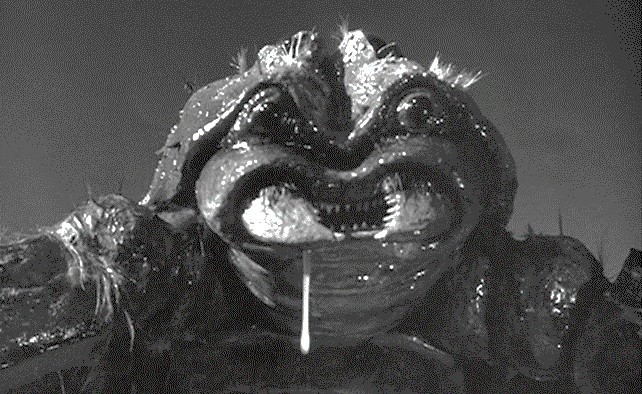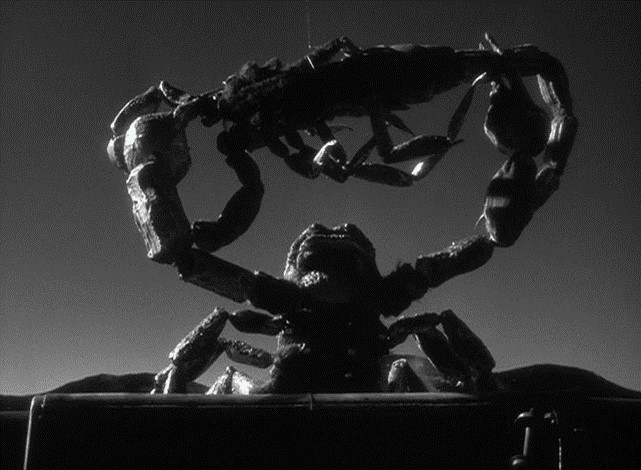Directed by Edward Ludwig
1957, 88 minutes
Volcanic activity releases a giant scorpion from subterranean caverns beneath the Mexican countryside. Rancher Teresa Alvarez (Mara Corday) finds that her workers have fled in panic as the creature ravages the countryside. Geologists Hank Scott (Richard Denning) and Artur Ramos (Carlos Rivas) are enlisted by the Mexican government to investigate.
When James Whale’s Pretorious raised a glass with Doctor Frankenstein to a “new world of gods and monsters” in 1935 they might have been toasting twenty-first century cinema. Digital effects have created spectacle beyond imagination. Superheroes are more powerful, monsters more lifelike and viewers have become jaded. If you feel the need to cleanse your palate with the crafted charm of stop-frame animation you should seek out Edward Ludwig’s ‘The Black Scorpion’, a lesser-known entry in the career of animator Willis O’Brien, creator of King Kong. O’Brien, his life blighted by alcohol and personal tragedy was nearing the end of his powers, but he could still work magic. In the fifties, as now, screen monsters were everywhere. ‘The Beast from 20,000 Fathoms’ attacked New York (Eugène Lourié, 1953), ‘Godzilla’ flattened Tokyo (Ishirō Honda, 1954) and a colossal octopus grappled with the Golden Gate in ‘It Came from Beneath the Sea’ (Robert Gordon, 1955). Cinema, like all art, endlessly recycles successful product in pursuit of a quick buck and, fifty years later, Kong and Godzilla are still slugging away for box office supremacy. Ukrainian born Edward Ludwig directed almost 100 films in his hectic career. ‘The Black Scorpion’ benefits from his vast experience and shines, being much more competently staged than risible fare like ‘The Giant Claw’ (Fred F Sears) made in the same year.
Critics who bemoan the ubiquity of digital effects should remember that cinema belongs as much to the carnival showman as the documentarist. The magic of Méliès is as formative as the street scenes of the Lumières. Perhaps Gertie was to blame. In 1914 audiences flocked to see Gertie, a bumptious brontosaur animated as a line drawing by cartoonist Winsor McCay and the star of the first keyframe animated cartoon. Nearly 80 years later Steven Spielberg gave us his own ‘Gertie’ moment when he revealed his brachiosaur at the start of ‘Jurassic Park’ (1992) and launched the digital revolution in cinema special effects. McCay may have invented monster cinema: his 1912 animated short ‘The Rarebit Fiend’ shows a gigantic creature rampaging through city streets as the authorities try to bring it down. Twenty years later Kong climbed the Empire State and became one of the most iconic images of the twentieth century. Cinema has always been as much about magic as it is about message or narrative. In ‘The Black Scorpion’ O’Brien conjures life with rubber, paint, wire, and infinite patience. Spielberg’s dinosaurs, Lucas’s ‘galaxy far, far away’ and Jackson’s Middle Earth all owe a debt to McCay, O’Brien and his protégé Ray Harryhausen.
O’Brien’s exquisite model work brings Ludwig’s monstrous scorpions to life and his imaginative touches enrich the hackneyed storyline; when geologists venture below ground, they encounter an animated subterranean ecosystem with strange, jointed worms and a scurrying trapdoor spider. In some sequences stylized footage of a real scorpion is superimposed on live action plates. Although this may feel like a cheat, a cheaper alternative to elaborate model sets, these sinuous, looming shadows create an abstract, almost surreal tone. When scorpions invade Mexico City Ludwig evokes the ecstatic technique of Sergei Eisenstein in a rhythmically edited montage of wailing sirens, deadpan public announcements and stampeding extras which plays like a B movie ‘Battleship Potemkin’ (1926). Cinematic monsters are as much the product of our own fears as they are of the hands that bring them to life. The creature feature had its heyday during the Cold War as society considered the implications of the atomic age. Whilst some take critical stance others are hymns to the military-industrial complex, tonally close to propaganda or recruitment films. Weaponised science may unleash the beast but only experts and the armed forces can banish it. Gareth Edwards 21st century reboot of ‘Godzilla’ (2014) sidesteps the nuclear critique of the original but, like Emmerich’s 1996 incarnation it remains staunchly militaristic in tone. In ‘The Black Scorpion’ the Mexican army must rise to the challenge with an enthusiastic if slightly underwhelming display of military prowess.
Mexico and the United States may have enjoyed a relatively cordial relationship during the 1950s, but the ‘newsreel’ prologue of ‘The Black Scorpion’ crassly describes ‘benighted’ peasants praying for the safety of their families. Mexico is a volcanic hotspot and inequalities of land ownership mean that the poor have little choice but to live with the risk. Geologist Hank Scott (Richard Denning) is a typical example the scientific or military leading men of many of these films and we wonder whether he is in Mexico simply to study volcanoes or to furtively sniff out subterranean mineral deposits for some nebulous corporation. Mexican characters, like scientists Dr Velazco played by patrician Carlos Múzquiz avoid caricature but maintain an air of reverent subservience and the major roles in ‘Black Scorpion’ are filled by American actors. Imposing beef baroness Teresa Alvarez (played by Mara Corday) manages local labour disputes by appealing to her workers sense of loyalty without recourse to messy union negotiations; an appropriate role model for contemporary US observers concerned about communist infiltration of Mexican labour organisations. Recent political events demonstrate that for many American voters, such simplistic, stereotyped cultural representations still obscure the complex history of America’s relationship with Mexico. ‘The Black Scorpion’ like the inferior ‘Reptilicus’ (Sidney W Pink, 1961) or Nathan Juran’s ‘20 Million Miles to Earth’ feels like an awkward cinematic adjunct of the Marshall Plan that offers B feature Hollywood investment in return for cheap foreign labour and travelogue locations. Apart from a few notable exceptions, like Lewis Teague’s ‘Alligator’ (1980), the creature feature is innately conservative and ‘The Black Scorpion’ demonstrates all the limitations of fifties gender politics. Richard Denning may have more charm than Kenneth Tobey’s square headed, oleaginous war hawk in ‘It Came from Beneath the Sea’ but his romantic pursuit of Mara Corday has all the subtle charm of a guided missile.
Our emotional relationship with screen monsters is complex and anthropomorphic. Kong’s risqué fixation with Fay Wray along with its uncomfortable racial undertones was smoothed into a more acceptable family frame in ‘Mighty Joe Young’ (Ernest B Schoedsack, 1949). In Peter Jackson’s reverential Kong remake (2005) Ann Darrow (Naomi Watts) recognises Kong’s essential nobility and their relationship becomes a tender romance. When Roland Emmerich endowed Godzilla with a more reptilian physiology in his nineties remake fans rejected it wholesale. Gareth Edwards po-faced reboot (2014) and its sequels have used state of the art digital technology to recreate the look and feel of an actor in a monster suit. The more human frame makes Godzilla seem cuddlier, like a huge teddy bear. Cinematic monsters personify basic, sometimes taboo human desires. They repel and attract us simultaneously. Children relate to monsters with a mixture of fear and love which mirrors their relationships with adults. Nacho Vigalondo’s ‘Colossal’ (2017) tries ambitiously to deconstruct the psychology that underlies these responses but unfortunately falls back on cliché. Viewer reaction to ‘The Black Scorpion’ is less conflicted. For most of us, arthropods have too many legs and too many eyes, they seem designed to inspire fear. In popular imagination if the spider, with its silken traps is an assassin then the scorpion with its armoured body, pincers and ever ready sting is a soldier. Ludwig deploys O’Brien’s warlike scorpions in a series of brilliantly staged set pieces. In a particularly memorable sequence, they attack a crowded passenger train. The action plays like a demented fifties ‘Starship Troopers’ (Paul Verhoeven, 1997) as blood-crazed scorpions squabble over the bodies of their screaming victims. As cultural industries struggle to adapt in the face of pandemic there is a sense that the dominance of effects-driven cinema ushered in by George Lucas and Steven Spielberg the late seventies may be failing. Audiences sated with spectacle crave more intimate films on a human scale and many would argue that this represents a long overdue return to ‘serious’ cinema. Certainly, it is difficult to justify the cost of spectacle cinema, but we must also recognise that a world bereft of “gods and monsters” is a more sombre place. If you can survive the sting of rampaging chauvinism these black scorpions deliver delirious late-night entertainment.
Quote
“We just saw a worm thirty feet long!” Hank Scott (Richard Denning)
Connections
Film
‘King Kong’ Directed by Merian C Cooper (1933)
‘It came from Beneath the Sea’ Directed by Robert Gordon (1955)
‘The Giant Claw’ Directed by Fred F Sears (1957)
‘Reptilicus’ Directed by Sidney W Pink, (1961)
‘Valley of Gwangi’ Directed by Jim O’Connolly, (1969)
‘Q: The Winged Serpent’ Directed by Larry Cohen, (1982)
‘Colossal’ Directed by Nacho Vigalondo, (2016)
Reading
Terry Rugeley, Epic Mexico, University of Oklahoma Press, 2020, ISBN 9780806167077
Reid Mitenbuler, Wild Minds: The artists and rivalries that inspired the golden age of animation, Atlantic Monthly Press, 2020, ISBN 9780802129383



You must be logged in to post a comment.